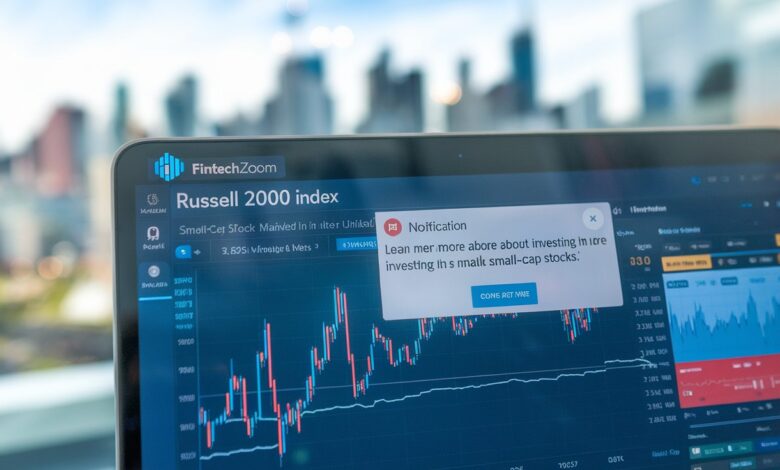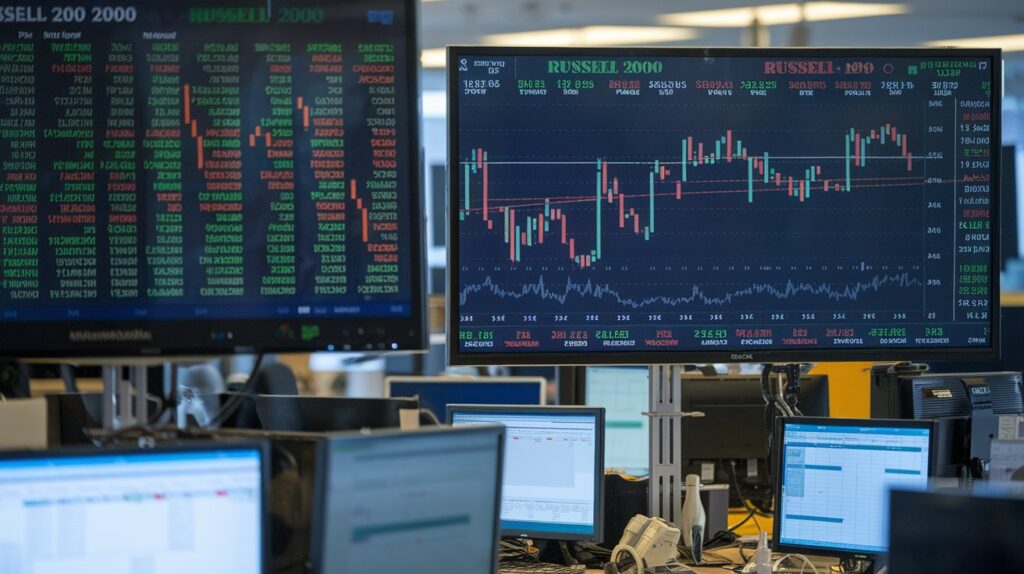FintechZoom Russell 2000: Your Smart Guide to Small-Cap Investing

Have you ever felt overwhelmed trying to understand the stock market? You’re not alone. When I first started exploring investment opportunities, the sheer volume of data, indices, and financial jargon felt like learning a foreign language. That’s when I discovered how platforms like FintechZoom make complex market information accessible especially when it comes to tracking the Russell 2000 index.
In Today’s articles,The Russell 2000 represents something special in the investment world. While everyone talks about the big-name stocks in the S&P 500, this index focuses on smaller American companies the underdogs that often become tomorrow’s success stories. And FintechZoom has become one of the most reliable sources for understanding what’s happening in this dynamic corner of the market.
Let me walk you through everything you need to know about FintechZoom’s Russell 2000 coverage and why it matters for your financial future.
What Exactly Is the Russell 2000 Index?
Think of the Russell 2000 as a snapshot of America’s smaller businesses. While the S&P 500 tracks 500 of the largest U.S. companies the household names everyone recognizes the Russell 2000 monitors 2,000 smaller public companies that represent a different slice of the economy.
These aren’t the Apples and Amazons of the world. These are regional banks, emerging tech firms, healthcare innovators, and manufacturing companies with market capitalizations typically ranging from about $300 million to $2 billion. They’re what investors call “small-cap stocks.”
Why does this matter? Small companies often have more room to grow than established giants. They’re closer to Main Street America, more responsive to domestic economic changes, and can sometimes deliver explosive growth when they hit the right formula. Of course, they can also be more volatile which is where quality information sources like FintechZoom become invaluable.
The Russell 2000 is actually part of a larger family called the Russell 3000 Index, which covers the 3,000 largest U.S. companies. The Russell 2000 represents the smallest two-thirds of that group, giving investors a pure play on America’s small business sector.

The Role of Financial Technology in Modern Investing
The rise of platforms like FintechZoom represents a broader revolution in how individuals access financial information. Twenty years ago, tracking indices like the Russell 2000 required expensive data subscriptions or brokerage relationships. Today, comprehensive market data sits at your fingertips, often for free.
This democratization of financial information levels the playing field between institutional and retail investors. You can access the same real-time Russell 2000 data that professional money managers see. You can read analysis from respected financial experts without paying for expensive newsletters. You can compare indices, analyze sector trends, and build investment theses using professional-grade tools.
FintechZoom exemplifies this transformation. The platform combines sophisticated data delivery with user-friendly presentation, making complex market information accessible to everyone from investment beginners to experienced traders.
How Global Events Ripple Through Small Caps
One aspect of Russell 2000 investing that surprises many people: how sensitive these domestic-focused companies can be to international events. Even though small caps generate most revenue domestically, global factors significantly impact their performance.
Interest rate decisions by foreign central banks influence currency values and international capital flows. Trade policies affect supply chains and input costs. Geopolitical tensions impact investor risk appetite broadly. Energy price swings from global markets affect transportation and manufacturing costs.
FintechZoom’s Russell 2000 coverage excels at connecting these global dots. When international news breaks, the platform explains potential implications for small-cap stocks, helping you understand why the index might be moving based on seemingly distant events.
I remember when European banking concerns caused Russell 2000 volatility despite the issues being overseas. FintechZoom’s analysis explained the connection how global risk aversion affects smaller, more vulnerable companies first helping me make sense of market movements that otherwise seemed disconnected from American small business fundamentals.
Why FintechZoom Has Become Essential for Market Tracking
In my years following financial markets, I’ve seen countless websites claim to offer the best investment information. Most either overwhelm you with data you can’t understand or oversimplify to the point of uselessness. FintechZoom strikes a different balance.
What makes FintechZoom stand out for Russell 2000 coverage? Several things caught my attention immediately. First, the platform provides real-time data without requiring you to be a finance professional to interpret it. When the market opens and small-cap stocks start moving, you can see what’s happening as it unfolds.
Second, FintechZoom excels at context. Numbers alone don’t tell the full story. The site explains why the Russell 2000 might be rising or falling on any given day whether it’s interest rate changes, sector rotation, economic reports, or global events impacting investor sentiment.
Third, the educational component sets FintechZoom apart. The platform doesn’t assume you already know everything. Instead, it builds your knowledge gradually, helping you understand not just what’s happening but why it matters for your investment strategy.
I’ve recommended FintechZoom to friends just starting their investment journeys, and the feedback has been consistently positive. People appreciate having one trusted source where they can check Russell 2000 performance, read expert analysis, and learn about market dynamics without needing a finance degree.

Understanding Small-Cap Stocks: The Heart of the Russell 2000
Let me share something I learned the hard way: small-cap stocks behave differently than large-cap stocks, and understanding these differences is crucial for successful investing.
Small-cap companies those in the Russell 2000 typically have more growth potential than established corporations. They’re at earlier stages of development, often innovating in their industries or serving niche markets where they can expand rapidly. When a small company finds the right product-market fit, its stock can multiply several times over.
However, this growth potential comes with increased risk. Smaller companies have less financial cushion during economic downturns. They may struggle to access credit when lending tightens. Their stock prices can swing more dramatically based on quarterly earnings reports or management changes.
This volatility is why tracking the Russell 2000 through reliable sources like FintechZoom matters so much. You need to understand the broader trends affecting small caps as a group, not just individual company news. Are small companies collectively gaining strength? Are investors rotating from large caps to small caps seeking better returns? Is the economic environment favorable for smaller businesses?
FintechZoom’s Russell 2000 coverage helps answer these questions by presenting data, charts, and analysis that reveal the bigger picture. You can see sector performance breakdowns, compare small-cap trends to large-cap movements, and understand what analysts predict for the coming months.
How the Russell 2000 Reflects Economic Health
Here’s something fascinating I’ve observed: the Russell 2000 often acts as an economic leading indicator. Because smaller companies are more sensitive to domestic economic conditions, their collective performance can signal changes before they show up in broader economic data.
When the Russell 2000 is climbing steadily, it typically means small businesses are optimistic, expanding operations, and seeing healthy demand for their products or services. This grassroots economic strength often precedes improvements in employment numbers and GDP growth.
Conversely, when the index struggles, it can indicate that lending conditions are tightening, consumer spending is weakening, or business confidence is declining. Small companies feel these pressures first because they lack the financial resources and market power of larger corporations.
During my years tracking markets, I’ve learned to watch Russell 2000 performance on FintechZoom as an early warning system. When small caps start underperforming despite positive news about large-cap stocks, I pay attention it often signals underlying economic concerns that haven’t hit mainstream awareness yet.
Key Sectors Within the Russell 2000
One aspect of the Russell 2000 that FintechZoom covers particularly well is sector diversity. The index isn’t dominated by any single industry, which provides natural diversification but also means understanding sector trends becomes important.
Financial Services: Regional banks and financial technology companies represent a significant portion of the Russell 2000. These institutions are highly sensitive to interest rate changes when rates rise, their lending margins can improve, but higher rates can also slow loan demand.
Healthcare: The index includes numerous biotechnology firms, medical device manufacturers, and healthcare service companies. This sector often moves based on FDA approvals, clinical trial results, and healthcare policy changes.
Technology: While not dominated by tech giants like the Nasdaq, the Russell 2000 features many smaller software companies, IT services firms, and specialized technology providers. These companies often lead innovation in niche markets.
Industrials: Manufacturing companies, specialty industrial firms, and business service providers give the index exposure to America’s productive economy. These stocks often track closely with domestic economic growth.
Consumer Discretionary: Retailers, restaurants, and entertainment companies in the Russell 2000 reflect consumer spending trends. When Americans have money to spend, these companies often benefit disproportionately.
FintechZoom’s sector breakdowns help you understand which industries are driving Russell 2000 performance on any given day. This granular insight proves invaluable when making investment decisions or simply understanding market dynamics.
Russell 2000 vs. S&P 500: Understanding the Difference
A question I hear constantly: “Why should I care about the Russell 2000 when everyone talks about the S&P 500?” It’s a fair question that deserves a thorough answer.
The S&P 500 tracks America’s 500 largest companies the blue-chip stocks that dominate headlines and retirement portfolios. These companies have proven business models, global reach, and financial stability. They’re the safe harbor in uncertain times.
The Russell 2000, by contrast, represents growth potential and economic dynamism. These smaller companies are building the next generation of American business. Some will fail, but others will become tomorrow’s S&P 500 constituents.
Performance patterns differ significantly between these indices. During economic expansions, small caps often outperform large caps as investors seek higher growth. During contractions or uncertain periods, large caps typically hold value better due to their financial strength and diversified operations.
FintechZoom makes comparing these indices straightforward. You can see side-by-side performance charts, understand relative valuations, and read analysis about when to favor one over the other. This comparative perspective helps you make strategic allocation decisions in your portfolio.
Recent Performance Trends in 2025
As someone who checks market data daily, I’ve watched the Russell 2000’s journey through 2025 with great interest. After facing significant headwinds in 2023 and 2024 when rising interest rates hit small companies particularly hard we’re seeing signs of recovery.
The Federal Reserve’s current stance on interest rates has created a more favorable environment for small-cap stocks. As borrowing costs stabilize and investors look beyond mega-cap technology stocks for opportunities, money has been flowing back into the Russell 2000.
FintechZoom’s coverage has been invaluable for understanding these shifts. The platform explains how interest rate decisions impact small companies differently than large ones, why certain sectors within the Russell 2000 are outperforming, and what analysts expect for the remainder of 2025.
One trend I find particularly interesting: many financial experts believe we’re entering a period where small caps could outperform large caps as economic growth broadens beyond the handful of technology giants that dominated recent years. FintechZoom’s Russell 2000 section regularly features expert commentary on these potential rotation trends.
Practical Investment Strategies for Small Caps
Let me share some practical wisdom I’ve gathered about investing in Russell 2000 stocks. First, diversification is crucial. Individual small-cap stocks can be volatile, so spreading your investment across many companies either through ETFs that track the Russell 2000 or through careful portfolio construction reduces risk.
Second, patience pays off. Small companies need time to execute growth strategies. Short-term volatility shouldn’t shake your conviction if the underlying business fundamentals remain strong. I’ve learned this lesson through both successes and mistakes over the years.
Third, stay informed but don’t overtrade. This is where FintechZoom’s Russell 2000 coverage becomes strategically important. You want to understand what’s happening in the small-cap market without letting every daily fluctuation trigger impulsive decisions. The platform’s analysis helps distinguish meaningful trends from temporary noise.
Fourth, consider your risk tolerance honestly. Small-cap investing isn’t for everyone. If market volatility keeps you awake at night, maintaining a larger allocation to stable large-cap stocks makes sense. But for those with longer investment horizons and tolerance for ups and downs, small caps can deliver superior long-term returns.
Frequently Asked Questions About FintechZoom Russell 2000
FintechZoom provides comprehensive Russell 2000 coverage including real-time index prices, daily performance charts, sector breakdowns, expert analysis explaining market movements, and educational content about small-cap investing. You’ll find comparison tools to track the Russell 2000 against other major indices like the S&P 500, historical performance data, and regular updates about factors affecting small-cap stocks.
Russell 2000 stocks can work for beginners, but with important caveats. Small-cap stocks are generally more volatile than large-cap stocks, meaning prices can swing dramatically. For beginners, the safest approach is investing in ETFs that track the entire Russell 2000 index rather than picking individual small-cap stocks.
The frequency depends on your investment strategy and personality. Active traders might check multiple times daily, while long-term investors might review performance weekly or monthly. I recommend a middle ground: checking FintechZoom’s Russell 2000 section a few times weekly keeps you informed without encouraging impulsive reactions to normal market volatility.
Conclusion: Why FintechZoom Russell 2000 Deserves Your Attention
After years of tracking markets and exploring various information sources, I’ve come to rely on FintechZoom’s Russell 2000 coverage as an essential part of my investment routine. The platform offers something increasingly rare in our information-overloaded world: clarity without oversimplification.
The Russell 2000 index itself represents opportunity a window into America’s entrepreneurial spirit and the companies building our economic future. These aren’t the household names that dominate headlines, but they’re often where the most interesting growth stories unfold.
Whether you’re actively investing in small-cap stocks, building a diversified portfolio, or simply trying to understand economic trends, following the Russell 2000 through FintechZoom provides valuable insights. The platform’s combination of real-time data, expert analysis, and educational content makes complex market dynamics accessible.
My advice? Bookmark FintechZoom’s Russell 2000 section and make checking it part of your regular routine. You don’t need to obsess over every daily movement, but staying informed about small-cap trends will make you a more knowledgeable investor and help you spot opportunities others might miss. In the ever-changing landscape of financial markets, quality information sources like FintechZoom aren’t just helpful they’re essential for making confident, informed investment decisions.
Related Stories: NTDTVJP: Transforming Japan’s Media Landscape
Sodiceram: Where Art Meets Function in Home Design


